Mikhail Evgenievich Masson -
the founder of the archaeological school
in Central Asia
At the end of the last year the centenary from the birthday of Mikhail Evgenievich Masson was celebrated - the professor, doctor of historical and archaeological sciences, academician of the Academy of Sciences of Turkmenistan, outstanding archaeologist.
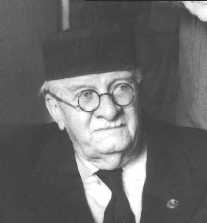 He was born on the 5th of December 1897 in Samarkand. Being a gymnasia pupil he took a great interest in this extraordinary town, its beauty, where everything - from the stern ancient settlement of Afrasiyab to the beautiful monuments of Registan absorbed the memory of the last centuries. As a teenager he took part in the excavations made on Afrasiab by V.L.Vyatkin, the local enthusiastic archaeologist. In particular, these excavations were related to the opening of traces of the unique Ulugbek's Observatory - the XV century. By the way, currently a small street running to this architectural monument, is named after the academician M.E.Masson.
He was born on the 5th of December 1897 in Samarkand. Being a gymnasia pupil he took a great interest in this extraordinary town, its beauty, where everything - from the stern ancient settlement of Afrasiyab to the beautiful monuments of Registan absorbed the memory of the last centuries. As a teenager he took part in the excavations made on Afrasiab by V.L.Vyatkin, the local enthusiastic archaeologist. In particular, these excavations were related to the opening of traces of the unique Ulugbek's Observatory - the XV century. By the way, currently a small street running to this architectural monument, is named after the academician M.E.Masson.
In 1916 he started studies at the Petrograd Polytechnical Institute planning to acquire a profession of an engineer-irrigator. But the life took unexpected change: he had been called up to military service and then took part in the hostilities at the South-West front, where he was chosen as a member of the Council of the workers and soldiers. In 1918 M.E.Masson came back to Samarkand.
Here he at once joined the activities related to investigation, protection and restoration of the Samarkand monuments. Soon he was appointed as the head of the Samarkand Oblast (provincial) Museum. Thanks to the investigations and work of M.E.Masson the collection of this Museum was enriched by various exhibits: from splendid panels of the Samanid palace, excavated in Afrasiyab to the collection of beatles that are met in Samarkand Oblast.
In 1924 M.E.Masson was sent in Tashkent - to work in the Turkistan (later Uzbek) Committee for Museums and protection of monuments of old times and art as the head of the archaeological department attached to the Main Museum of Middle Asia. At the same time he attended the courses at the Turkistan Institute for the Oriental Studies, and also was engaged into excavating and prospecting, in particular, he was the archaeological observer at restoration of the monuments and worked as an advisor on the museum matters in the Republics of Middle Asia.
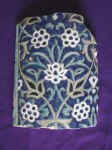 From 1929 to 1936 Mikhail Evgenievich learned the history of mining at the Geological Committee, where he created the excellent geological library combining the work as the head of the archaeological section of the Uzbek Committee for the museum matters and protection of monuments of the old times and art. During these years he prepared a number of works on the mining history in the Middle Asia at the medieval period. These works were based on his trips and observance of excavations of the ancient mines and on the investigation of the primary sources of the X-XV centuries.
From 1929 to 1936 Mikhail Evgenievich learned the history of mining at the Geological Committee, where he created the excellent geological library combining the work as the head of the archaeological section of the Uzbek Committee for the museum matters and protection of monuments of the old times and art. During these years he prepared a number of works on the mining history in the Middle Asia at the medieval period. These works were based on his trips and observance of excavations of the ancient mines and on the investigation of the primary sources of the X-XV centuries.
From 1936 M.E. Masson worked as the head of Chair for archaeology at the State University of Middle Asia (later Tashkent University). Here his wide knowledge and managerial abilities were especially brightened up. Here he founded the school of archaeology, further, its graduates became the leading archaeologists of Central Asia.
The characteristic trait of M.E. Masson - is selflessness and utmost dedication to his work in any direction: geological prospecting in the depopulated areas of Middle Asia, excavations of the vast ancient settlement, single grave or making a speech at the Conference.
M. E. Masson was a scientist with many-sided interests. Combination of his deep knowledge, command of classic oriental and European languages and variety of archaeological techniques predetermine cogency of his final historical conclusions.
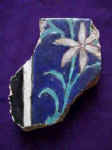 In his works he touched upon questions related to history and culture, economy of the early epochs, historic topography of towns and abandoned ancient settlements, history of mining and handicrafts, architectural heritage and many others. But along with this he was not an isolated scientist reserved only into his studies, but an energetic manager and organiser of scientific activities. The staff of the Chair for archaeology at the Tashkent State University headed by him until he was retired, delivered not only the lectures on general archaeology, but also a number of special lecture courses ranked from the archaeology of Middle Asia to the Oriental arts. He obliged all students to annually participate in the archaeological expeditions and resulting from this order upon graduating from the university his students were able to make archaeological excavations independently.
In his works he touched upon questions related to history and culture, economy of the early epochs, historic topography of towns and abandoned ancient settlements, history of mining and handicrafts, architectural heritage and many others. But along with this he was not an isolated scientist reserved only into his studies, but an energetic manager and organiser of scientific activities. The staff of the Chair for archaeology at the Tashkent State University headed by him until he was retired, delivered not only the lectures on general archaeology, but also a number of special lecture courses ranked from the archaeology of Middle Asia to the Oriental arts. He obliged all students to annually participate in the archaeological expeditions and resulting from this order upon graduating from the university his students were able to make archaeological excavations independently.
M.E.Masson carried out his activities throughout the whole territory of Middle Asia including Kazakhstan. In 1927 he made researches of Taraz and Sairam, two years later - of the mausoleum of Khodja Akhmed Yasawi in Turkistan. Later he wrote a small book about the mausoleum. He consulted some museums concerning a number of findings in Kazkahstan, in particular, from the burial ground located in the basin of the Nura river and especially, concerning mound burials of the XIII-XV centuries. He took part in the investigations of many monuments in Kyrghyzia. Thus, in 1945, we have jointly investigated of Gumbez Manas,- the masterpieces of the Middle Asian Architecture of the XIV century. During 20-ies being as the advisor on the museum matters at the Middle Asian level, he laid the foundation of the museum in Shymkent that is curreltly one of the town cultural centres.
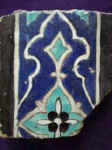 But the main objects of his work were located in Uzbekistan and Turkmenistan. In the 20-ies there was only primary prospecting there, beginning from the 30-ies the following large, long-term expeditions were undertaken :TACE - Termez Archaeological Complex Expedition (1936-1938); the expedition for the archaeological supervision at the construction of the Great Fergana Channel (1936), STACE - South-Turkmenistan Archaeological Complex Expedition (1946-1968), KAE - Kesh Archaeological Expedition (from 1963).
But the main objects of his work were located in Uzbekistan and Turkmenistan. In the 20-ies there was only primary prospecting there, beginning from the 30-ies the following large, long-term expeditions were undertaken :TACE - Termez Archaeological Complex Expedition (1936-1938); the expedition for the archaeological supervision at the construction of the Great Fergana Channel (1936), STACE - South-Turkmenistan Archaeological Complex Expedition (1946-1968), KAE - Kesh Archaeological Expedition (from 1963).
In the above abbreviations there is the letter "C" - complex. M.E. Masson believed this idea was very important as he considered that not only archaeologists are to take part in the archaeological works, they are to be assisted by other specialists - architects, biologists, geologists, that may solve various questions related to the history of architecture, technology of various productions etc. As for me, the participation in the TACE and STACE took me an opportunity of a direct investigation of the architectural monuments (up to one hundred and fifty objects, the greater part of which had not been investigated earlier.), their measurements, descriptions, making a comparative analysis and identifying the main trend of development of architecture in the target regions.
The outcome of the complex expeditions, arranged and headed by M.E.Masson, was the publications of materials edited by him. Only referring to the STACE 23 volumes of "The STACE materials" were issued excluding the articles. Students prepared degree works, scientific researchers defended theses on the base of their participation in the long-term expeditions.
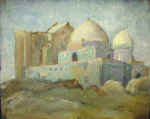 |
|
The
mausoleum.
The drawing of M.E.Masson |
I would like to add that the composition of the expeditions was international: the expeditions included representatives of the Middle Asian Republics, Russia, Caucasus. In these expeditions gained the experience such archaeologists as Kh.Alyspaev and M.Merschiev, that later worked in Kazakhstan. Among the participants of expeditions and other activities headed by M.E.Masson the present academicians and members-correspondents of the Academies of Sciences of CIS should be mentioned.
The centenary of the birthday of M.E.Masson was marked by the meetings held in Tashkent, Ashgabad, arrangement of the annual "Masson readings" held in Tashkent. M.E.Masson left fond memories of himself as the scientist devoted all his life and energy to the science, its future.
G. Pugachenkova,
Kumbez, 1998




